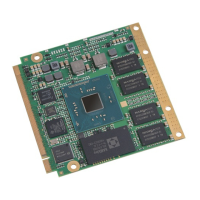MSC Q7-BT MSC_Q7-BT_User_Manual.pdf 25 / 113
2.4 Power Management
The MSC Q7-BT modules have a number of mechanisms for regulating power. These are described shortly below and also in the BIOS section of this
manual. In order make use of the power management features the operating system must be ACPI capable. The operating system then adjusts the
power consumption depending on the current load on the CPU and the power management settings configured in the BIOS and operating system.
1. C-states
C-states are used by the OS to save additional power when the CPU is idle
2. Speed stepping (EIST)
Speed stepping (EIST – see Technotes in this manual) is used while the CPU is active to achieve optimum power consumption for the current load on
the CPU.
3. Recommendations for real time applications
For applications which require real-time, low latency performance it is recommended to configure the OS for full power / maximum performance
operation. It is also possible to disable the C-states in the BIOS setup. It is not recommended to disable the Speed Stepping in BIOS Setup, since the
speed stepping is also used for thermal management.
In order to assure consistent latency times it is also recommended to disable any turbo or boost modes (if available) for CPU or graphics in the BIOS
setup.
2.5 Use Conditions
The Use Conditions define run-time parameters such as the operating mode (eg. 24/7), activity factor, max frequency, temperature range etc. for the
application being used.
Certain Use Conditions may have an effect on the lifetime of the product.
Please consult MSC Technical Support if there are questions concerning specific Use Conditions when using the selected MSC module for the target
application.

